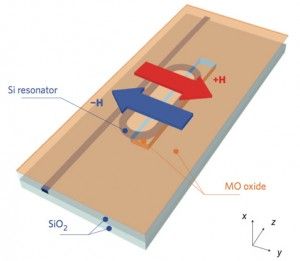
Light-emitting diodes (LEDs) are a cornerstone of consumer tech. They make thin-and-light TVs and smartphones possible, provide efficient household, handheld, and automobile illumination, and, of course, without LEDs your router would not have blinkenlights. Thanks to some engineers from MIT, though, a new diode looks set to steal the humble LED’s thunder. Dubbed a diode for light, and crafted using standard silicon chip fabrication techniques, this is a key discovery that will pave the path to photonic (as opposed to electronic) pathways on computer chips and circuit boards.
In electronics, a diode is a gate that only allows electrons to pass in one direction (and with an LED, it also emits light at the same time). In this case, the diode for light — which is made from a thin layer of garnet — is transparent in one direction, but opaque in the other. Garnet is usually hard to deposit on a silicon wafer, but the MIT researchers found a way to do it — and that’s really the meat of this discovery.
 Basically, it’s now possible, with regular chip-fab tools, to create an integrated silicon circuit with optical, rather than electronic, interconnects — both internally, and between other chips. Photons, moving through the kind of transparent metamaterials that would be required to make such a circuit, move a lot faster than electrons. Furthermore, optical channels, through wavelength-division multiplexing, can carry a lot more data than electric signals. At the moment, hundreds of copper wires connect the CPU, northbridge, and memory — with on-chip photonic controllers, a motherboard might only have 10 or 20 channels.
Basically, it’s now possible, with regular chip-fab tools, to create an integrated silicon circuit with optical, rather than electronic, interconnects — both internally, and between other chips. Photons, moving through the kind of transparent metamaterials that would be required to make such a circuit, move a lot faster than electrons. Furthermore, optical channels, through wavelength-division multiplexing, can carry a lot more data than electric signals. At the moment, hundreds of copper wires connect the CPU, northbridge, and memory — with on-chip photonic controllers, a motherboard might only have 10 or 20 channels.
Read more
















